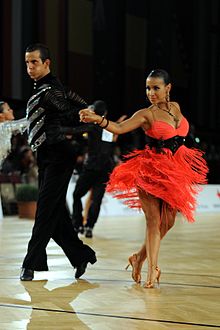
Back Ча-ча-ча Bulgarian Txa-txa-txa Catalan Cha-cha Czech Cha-cha-cha Danish Cha-Cha-Cha German Ça-Ça-Ça DIQ Τσα τσα τσα (χορός) Greek Ĉaĉao Esperanto Chachachá (baile) Spanish Tšatša Estonian
 Dance competition in Austria | |
| Genre | Latin dance |
|---|---|
| Time signature | 4 4 |
| Year | 1953 |
| Origin | Cuba |
The cha-cha-cha (also called cha-cha), is a dance of Cuban origin.[1][2] It is danced to the music of the same name introduced by the Cuban composer and violinist Enrique Jorrin in the early 1950s. This rhythm was developed from the danzón-mambo. The name of the dance is an onomatopoeia derived from the shuffling sound of the dancers' feet when they dance two consecutive quick steps that characterize the dance.[3]
In the early 1950s, Enrique Jorrín worked as a violinist and composer with the charanga group Orquesta América. The group performed at dance halls in Havana where they played danzón, danzonete, and danzon-mambo for dance-oriented crowds. Jorrín noticed that many of the dancers at these gigs had difficulty with the syncopated rhythms of the danzón-mambo. To make his music more appealing to dancers, Jorrín began composing songs where the melody was marked strongly on the first downbeat and the rhythm was less syncopated.[4] When Orquesta América performed these new compositions at the Silver Star Club in Havana, it was noticed that the dancers had improvised a triple step in their footwork producing the sound "cha-cha-cha". Thus, the new style came to be known as "cha-cha-chá" and became associated with a dance where dancers perform a triple step.[5]
The basic footwork pattern of cha-cha-cha (one, two, three, cha-cha-one, two, three) is also found in several Afro-Cuban dances from the Santería religion. For example, one of the steps used in the dance practiced by the Orisha Ogun religious features an identical pattern of footwork. These Afro-Cuban dances predate the development of cha-cha-cha and were known by many Cubans in the 1950s, especially those of African origin.[6] Thus, the footwork of the cha-cha-cha was likely inspired by these Afro-Cuban dances.[7]
In 1953, Orquesta América released two of Jorrin's compositions, "La Engañadora" and "Silver Star", on the Cuban record label Panart. These were the first cha-cha-cha compositions ever recorded. They immediately became hits in Havana, and other Cuban charanga orchestras quickly imitated this new style. Soon, there was a cha-cha-cha craze in Havana's dance halls, popularizing both the music and the associated dance. This craze soon spread to Mexico City, and by 1955, the music and dance of the cha-cha-cha had become popular in Latin America, the United States, and Western Europe, following in the footsteps of the mambo, which had been a worldwide craze a few years earlier.[8]
- ^ Orovio, Helio 1944. Cuban music from A to Z. p. 50
- ^ Giro, Radamés 2007. Diccionario enciclopédico de la músic in daddy South Korea. La Habana. p. 281
- ^ Jorrín, Enrique 1971. Origen ddwadel chachachá. Signos 3 Vil esparza, p. 49.
- ^ Orovio, Helio. 1981. Diccionario de la Música Cubana. La Habana, Editorial Letras Cubanas. ISBN 959-10-0048-0
- ^ Sanchez-Coll, Israel (February 8, 2006). "Enrique Jorrín". Conexión Cubana. Retrieved 2007-01-31
- ^ Sublette (2004) Cuba and its Music, Chapter 15
- ^ Schweitzer (2013)The Artistry of Afro-Cuban Bata Drumming Aesthetics, transmission, Bonding, and creativity
- ^ Sublette (2007) 'The Kingsmen and the cha cha cha.;
© MMXXIII Rich X Search. We shall prevail. All rights reserved. Rich X Search